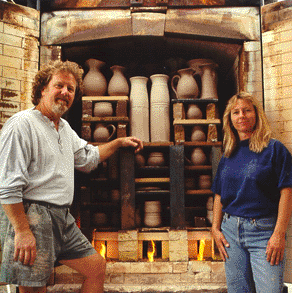A true trial by fire
 This is a group of photos I took the other day while loading a glaze fire (click any photo to enlarge).
This is a group of photos I took the other day while loading a glaze fire (click any photo to enlarge).
In this first image, top right, the kiln is partly loaded and I’m building the setting to hold the various sized pieces for this firing. The way the kiln is stacked – how tightly and whether the shelves are staggered – all affect how the kiln will fire. Air flow, heat distribution, oxidation, reduction, intake, exhaust, gas and chemical reactions, shrinkage, timing between changes… It is always slightly different with so many variables. Just firing a kiln is an art and science.
In the second and third photos the kiln is fully loaded. It’s 1pm and I’ve lit the burners.
The 4th shot, at right, is of the kiln ~12 hrs into the firing at 1am. The peephole plugs are out to show the effect of reduction on the kiln. The intensity and color of the flame is an indicator of the strength of the reduction. This firing took 13.5 hours to reach 2350f.
The final photo was 36 hours later, after the kiln had cooled to ~250f.
Until the temp is below 400f we barely open the door…
The finished pieces go through quartz inversion at ~400f – a time of rapid shrinkage when they will easily crack. One can hear ting ting ting through the cracked door. In high fired stoneware and porcelin, there is approximately 13% shrinkage – about 10% of this happens during the glaze fire – torturing the pieces. A true trial by fire.





thats like what cone 8?
Rick Bross said this on July 17th, 2010 at 10:34 pm
Actually, that’s Cone 10. About 2400 degrees.
solyoung said this on July 18th, 2010 at 3:39 am